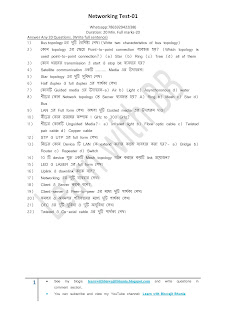Computer Application(HS)
A.
Logic Gate and Combinational Circuits (15 marks)
1. Logic Gates
– OR, AND, NOT, XOR, X-NOR Gates
2. Universal Gates
– NAND and NOR Gate, Basic gates using Universal Gates
3. Two Level Circuits-SOP,POS
4. Combinational Circuits-
a. Half
Adder & Full Adder (definition and representation), Full Adder using Half
Adders only,
b. Half
Subtractor & Full Subtractor (definition and representation) ,
c. 4
bit Adder and Subtractor Circuit,
d. Multiplexer
(4x1) and De-multiplexer (1x4),
e. Decoder
(Maximum 3 bits), and Encoder (Decimal to Binary, Octal to Binary)
B.
Networking (20 marks)
1.
Introduction
to Networking (Definition, Advantage, Disadvantage, Application)
2. Analogue
and Digital Communication
3. Modes
of Communication : Simplex, Half Duplex and Full Duplex Communication
4. Types
of Network – LAN, MAN, WAN
5. Network
Architecture : Client Server & Peer-to-Peer Networks
6. Serial
and Parallel Communication
7. Bandwidth,
Channel Capacity, Baud
8. Synchronous
and Asynchronous Transmission Modes
9. Baseband
and Broadband Networks
10. Components of a Network-
Servers (File server, Communication Server, Print Server) and Workstation, NIC
11. Network
Media-Guided Media( Cables – UTP, STP, Co-axial, Fibre Optic), Unguided Media(
Infrared, Radio & Microwave Communication, Satellite)
12. Network
Operating System – Characteristics
13. Network Topologies –Bus,
Ring, Star
14. Network Connecting Devices – Hub,
Repeater, Bridge, Switch, Router, Gateways
15. LAN Protocols-(Ethernet
(CSMA / CD) and Token Ring Protocol)
16. Switching Technique(Circuit,
Message and Packet Switching)
17. Use of MODEM
18. TCP / IP Protocols - TCP, IP, UDP, FTP, HTTP, TELNET
19. IP Addressing(Class
A, Class B, Class C IP address)
20. Domain Name System and Domain Name Server
21. URL
22. Introduction to Internet
23. Basic
requirement for connecting to the Internet, ISP
24. Services
provided by Internet – www, browser, e-mail, search engine, socialnetworking
25. Networking
Security – Computer Virus, Concept of Firewall, Password
26. HTML-
Basic Page Design, Using Ordered and Unordered Lists, Using Image, Hyper
linking,Using Tables
C.
Database Management System (15 marks)
1. Introduction
of Database :Definition, Advantage and disadvantages
of DBMS, Database Languages (DDL, DML, DCL), Data Dictionary, Metadata, Database
Schema and Instance, DBMS and its components
2. Various
Data Models – ER Model, Hierarchical Model, Network Model, RelationalModel
(only concepts)
3. Different
Database Users, Functions of DBA
4. Relational
Model- Concept of Relation, Topple, Attribute,
Domain, Degree, Cardinality, Concept of Keys (Super Key, Candidate Key, Primary
Key, Alternate Key) , Concept of Relationships(1:1, 1:N, N:M relationships).
5. Database
Constraints – Equity Integrity Constraint, Domain Constraint, ReferentialIntegrity
Constraint and Concept of Foreign Key
6. Relational
Algebra- Fundamental Operations( Selection Operation, Projection
Operation, Set Operation, Cartesian Product, Natural Join Operation)
7. SQL-Simple
SELECT Queries (SELECT, FROM, WHERE, DISTINCT, AND, OR, IN,NOT IN, BETWEEN,
LIKE, ORDER BY)
D.
Introduction to Spread Sheet – (MS Office 2007 or compatible) (10 marks)
1. Introduction
to Excel-Concept of Workbook, Worksheet, Row, Column, Cell
2. Creating
Opening, Editing, Saving a Workbook
3. Changing
Row and Column widths
4. Formatting
cells
5. Different
data types in Excel
6. Entering
labels and values
7. Use
of following inbuilt functions only – SUM, PRODUCT, AVERAGE, MAX, MIN,ROUND,
COUNT, COUNTIF, IF, AND, OR, NOT, DATE, TIME, NOW,CONCATENATE, UPPER, LOWER
8. Copying
Cells – Relative, Absolute and Mixed Referencing
9. Making
calculations and re-calculations
10. Auto
fill, Fill with series
11. Conditional
Formatting
12. Sorting
and Filtering Data (use of Auto Filter)
13. Goal
Seek
14. Hiding
Rows and Columns
15. Use
of Macros
16. Creating
Line Diagrams, Pie Charts, Bar Graphs
E.
Using MS Access (MS Office 2007 or compatible) (10 marks)
1. Introduction
to Access
2. Table
creating using Design View and Wizard
3. Different
data types in Access
4. Manipulation
of data using Access facilities – Inserting, Updating, Deleting data
5. Creating
Relationships between Tables
6. Form
creation using Wizard, Auto Form
7. Query
generation using Design View
8. Report
generation using Wizard, Auto Report
E.
Practical (30 marks)
1. Using
MS Excel and Access (10 marks)
2. Web
Page design using HTML (5 marks)
3. Project
Work (two projects) (10 marks)
a. Suggestive
Topics:
i. Application
of Excel:Using Excel creation of Mark Sheet, Balance Sheet, Monthly / Yearly
Expenditure, Reports
ii. Web
page designing using HTML (minimum 5 linked pages)-Travel and Tourism, Festivals,
Book Catalogue, Pollution and pollution control
4. Viva
Voce (5 marks)
BOOK DETAILS
- 1. Guha
& Pal-New Light Publisher(Bengali Edition)
- 2. Rajendranath
Giri- BB Kundu Grandsons(Bengali Edition)
- 3. Rajib
Mathur- Orient Blackswan(English Edition)
- 4. Aunpam
Karmakar- Dey Book Concern(English Edition)


Comments
Post a Comment